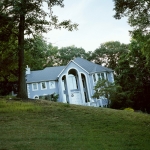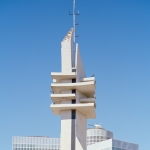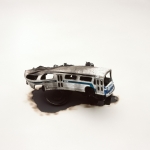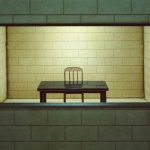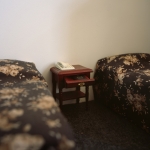As natural observers, we learn and understand with our fives senses—that is, until they’re impeded by things such as geography or time, in which case we look to outside experiences to fabricate our own. Enter photography: the window to shared places, moments and experiences from which we inform our own by others’ documented memories.
For photographer Yoav Friedländer, those shared memories are more than memories, but opportunities to develop personal meaning and effect. Because it’s not uncommon to experiences places we’ve never been to, ideas we’ve not yet thought of, Friedländer works his medium to accentuate those realities and false realities—the lived and the quasi-lived. With models and stories, he creates and recreates time and place, and with attention to both personal realism and objective realism, he beautifully captures his own life to shed light on interpretive familiarity in isolated documentations.
His exhibition CV spans the globe including a highly celebrated (and not to be missed!) event opening tomorrow night in New York: Bronx Calling: The Third AIM Biennial. And with that, we’re pleased to introduce you to Yoav Friedländer—because no one says it better than Friedländer himself.
Kindly introduce yourself.
My name is Yoav Friedländer, I am an Israeli artist based in Forest Hills, NY. I was a child born into the desert landscapes of Israel in 1985, and I grew up in the small town of Maale Adummim, just outside of Jerusalem, where I lived for 26 years until moving to New York. Unlike many other artists, I’ve set my mission to make work about the old rather than the new. I am looking back into things that altered our perception of the world, historical moments, memories and collective identity, with the goal to reintroduce these things and reexamine their affect on us. I am working with photography, which is the medium that interests me the most, and I am making scale models solely for the purpose of using them in my photographs.
You photograph a lot of scenic large-scale subjects, and then a lot of closed-off, intimate shots. How does your roll change in terms of both shots, and what details do you look for?
The outside world, the landscapes, the scenic subjects are not naive anymore. It seems that I have seen them before, the landscapes of places I haven’t visited yet or those I encounter for the first time. There is a vocabulary of images that I am using to photograph the places I visit. I am overlaying existing perspectives onto my subjects, because this is, in some way, how I see them. The relation between my closed-off intimate shots and the outside scenic world is my attempt at examining the influence that photographs have on our perception of reality and the real. The closed-off shots refer to my inner world, imagination and consciousness, the miniatures and scale models are a result of a real reference and accumulation of imaginative references. The outside world, in my images, is the real seen through preexisting perspective which predetermine how we will experience it.
The details that I am looking for are anchors—specific elements that repeat and accumulate in photographs. They give you the sense of familiarity with the subject, and they reach to your memory from which you would pull a chain of related memorable visuals. Sometimes these anchors are one of a kind, yet so distinct that it is unmistakable—like my image of 9/11, where the visual relationship between airplanes and buildings had changed forever.
What is the staging process like? Are these photos stories? Memories? Etc.
Each one of them is layered with both personal and collective story. Even when I am dealing with my personal memories I am trying to find a narrative that relates to our shared perception. We are living as individuals that are part of a greater whole, and we are affected personally yet in a similar manner. I am trying to share my point of view in a way that it can be deciphered by the collective. We are exposed to similar content and I am relying on that bank of visuals for others to be able to slowly uncover image. So to answer your question more directly, the staging process is charging the image with a story, mold it from a memory and code it with symbolic visuals and familiar perspective. The staging process should echo the known that hasn’t been examined directly.
Tell us about the juxtaposition between your photographs and the images of scale models. You say it’s “based on the recognition that our world
is informed by images, as photographs represent and
replace experiences & memories.”
The juxtaposition might appear strange at first but there is a well calculated strategy behind it. I am wandering the world knowing that I’ve previously seen a representation of it in photographs. Everything I see is being immediately compared to the images that came first. Try and think about places you’ve heard of, and yet you don’t have a visual reference for—can you think of any? Then think what happens when you finally visit one of those places, you’ve seen before in images, in person. I am making my photographs of the landscapes of both Israel and the U.S. knowing I am specifically responding to them as a ‘second hand’ experience. I’ve seen them before and now I am photographing them to juxtapose my recordings with all the ones that came before me.
I cannot avoid the fact that I’ve been informed of the world I live in through photographs and therefore I’ve set to explore that notion on purpose. The scale models are like a lab in which I examine the symbolic – the things that fix my perception of reality and the understanding of my identity. Juxtaposing these two photographic approaches creates a more complete search into the medium’s role in my understanding of the world. Our world is in-fact informed by images, an ever growing stream of images, that represent everything that we can could our might see for ourselves. I use Google street view, for example, and on purpose to find locations which I am interested in photographing. Google street view is a very good example of a world that is literally mapped by images that represent it, and for some, replace the need to see it in person. You cannot un-see an image and undo its affect on your perception. Our memories, and the way in which we remember are affected by the way we compose our world into images. What is eventually left out of our memory and what stays with us is also related to the way in which photographs represent our present and past.
Tell us about your scale-model building. How long do they take to make? Why is it important for you to remember your visual memories?
Dedicated scale model builders will spend the needed amount of time to make the most detailed, accurate and intricate scaled to size models. I only build them to the extent of the photograph I intend to make of them. They only need to function visually in a way that will activate our own preexisting knowledge of how things appear. To clarify on that, I am making half-baked models that are enough to foul our vision for a short while before being spotted. Once I have an idea for a model I will make it as fast as I can, because it is like waking up from a dream trying not to forget how vivid and exact it was. Some models took me less than 2 hours to make, and the longest one involved casting 5 sides of concrete, while waiting 24 hours for each side to dry.
It is important to remember the visual memories because they are not completely true. As time goes by I am loosing the vivacity of my memory, and what I visually forget is being filled with alternative visuals. Our memories are like our imagination—both derive from all of the things we’ve visually experienced and seen, the fictional and the real seamlessly blend together, and it is true for both parts of our memory and our imagination as a whole. It is important for me to photograph my visual memories because they are an evidence of a real experience infused with other visual sources that complete it.
Do you think of photography as a way of altering reality? Explain.
Photography inevitably alters reality. We cannot collectively remember our history or past without a record of it, and our society is dependent on inheriting knowledge and learning about our history. Photography is a chosen medium that is added to written history through which we examine our past, but due to its instantaneous characteristics, also our present. Photography represents our reality through a certain perspective and under specific contexts, it is not an objective recording of our world because it is the result of people with agenda who are in charge of making them. We actually hope that our recordings of reality will change it.
On the personal level we hope to record the good times and make it our personal history in a family album, and on the collective level we use photography to shed light on what we believe to be important to see and remember. But what really interests me is that the reality of our past is the one who is changing due to the act of photographing. While in the present moment the photograph is to be compared with reality, as the present turns into the past we can only look into it through its traces in the form of a photograph. When we see our past through the incomplete story of the photograph it alters our present actions and the future as an outcome. Photography alters our reality by giving us a contextualized, sometimes idealized, reflection of the past.
What is your take on Instagram? Is it softening photography as an artform? How do you feel about the images of idealized life versus real life, photographed life versus reality?
It seems that our practice of idealizing life had been a part of us, the human kind, ever since our inception. We’ve been doing so for so long that it is only natural that it will become a prominent part of Instagram. My friend and mentor David Levinthal told me that “we live the myth of our past,” and therefore I take it as if the real life derives from a myth anyhow.
Instagram definitely faces a challenge for photography as an art form, but the entire idea of automation, that allows you to create aesthetically accurate, well exposed images, and use highly sophisticated software to further edit images, gives artists who are using the medium of photography a run for their money. We don’t own the medium, and therefore Instagram doesn’t soften photography. It is our job to redefine what’s important in the medium of photography in our current day and age and to prove our vision. We should not expect the world to stand still and we should reflect our changing and evolving reality. I think that Instagram actually gave an amazing bank of visuals through which we can see, in real time, a reflection of the masses perception—it is exactly facing us with an idealized life versus real life and the photographed life versus reality. My job as an artist is to make the connection between these dots, and bring these subjects into our alertness.
for more from Yoav, visit his website: yoavfriedlander.com














